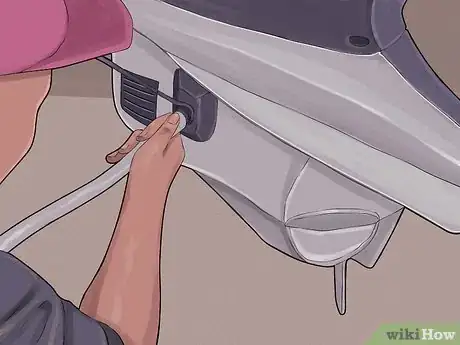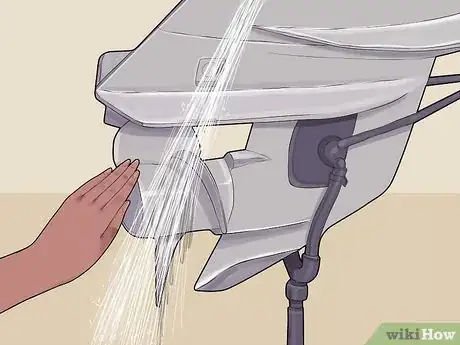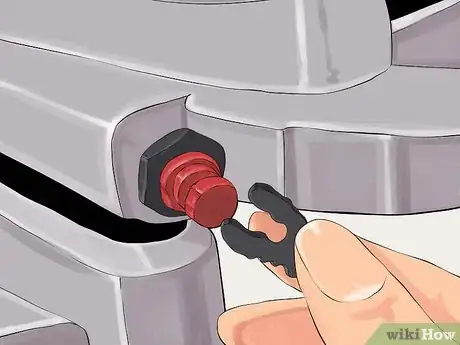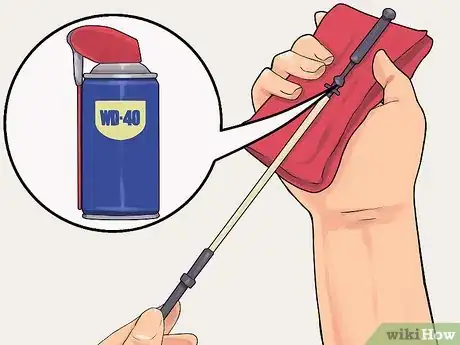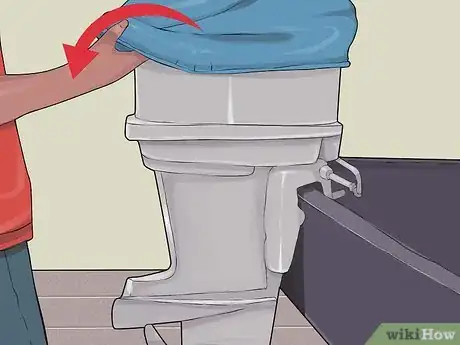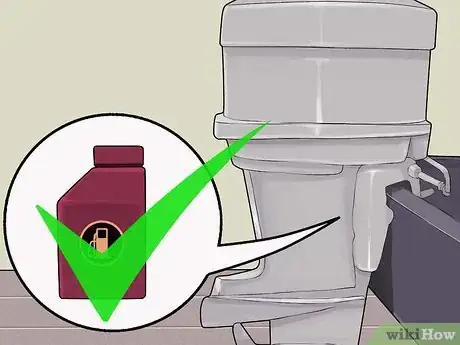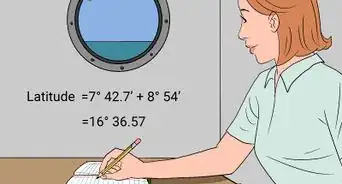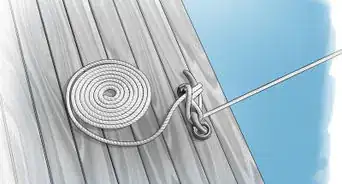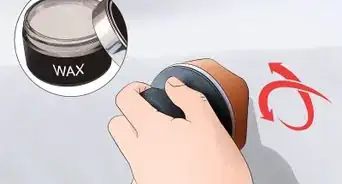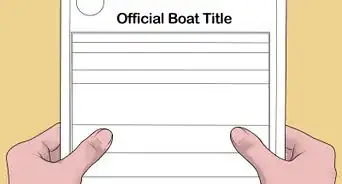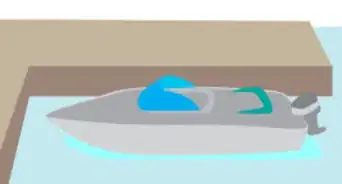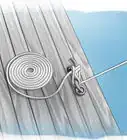wikiHow is a “wiki,” similar to Wikipedia, which means that many of our articles are co-written by multiple authors. To create this article, 11 people, some anonymous, worked to edit and improve it over time.
There are 9 references cited in this article, which can be found at the bottom of the page.
wikiHow marks an article as reader-approved once it receives enough positive feedback. In this case, 89% of readers who voted found the article helpful, earning it our reader-approved status.
This article has been viewed 193,466 times.
Learn more...
A little TLC and preventive boat motor maintenance will help with safe boating and keep your motor running well for years to come. This article will explain the basic steps you can take to extend the life of your outboard motor.
Steps
Cleaning and Maintaining the Motor After Your Outings
-
1Flush out the engine at home after every outing. This doesn't just apply to saltwater adventures, but to fresh water outings as well.
- If you have an older motor or one based upon an older design, you should buy a set of flushing "earmuffs": two flexible rubber seals attached to a metal clamp. One side can be attached to a garden hose, while the other is solid and will serve to plug a water intake. Slip the apparatus onto the lower unit where the water is taken in and then attach the earmuff to a garden hose. If there are additional water intakes that are not covered by the earmuffs, use duct tape to cover them.[1]
- Attach a garden hose to the earmuffs or mount and turn the water on. Newer motor designs already have mounts, and so the earmuffs are unnecessary.
- Start up the engine. The water pump will then flush out the system. (Practice safe boating and remember to stay clear of the prop and keep the motor out of gear.)
-
2While flushing the motor, check the water pump to make sure it has good water flow. Carefully put your finger through the stream of water exiting the motor. It should be warm, but not hot. If the output is not strong, you may have some debris stuck in the outflow tube. Immediately shut down the engine to prevent overheating and damage.
- If the flow tube is obstructed, insert a small piece of wire into the tube and work it back and forth (again, while the engine remains off). Start the engine again and check the output. If that doesn't solve the problem, you may need a new water pump impeller.
Advertisement -
3After flushing the engine, disconnect the fuel line (if applicable). Disconnect the fuel line if the boat is going to be stored for an extended period of time. You should allow the engine to burn the small amount of fuel that is in the carburetor. Old fuel can gum up an engine, and the best way to keep the motor running at a high level is to burn off all fuel remaining in the mechanism.[2]
- Be advised that if you own a two-stroke motor with more than one carburetor, the top carburetor will run dry first while all of the cylinders will continue to run. Without fuel, the top cylinder will not be getting any lubrication. Listen closely as the engine may get louder as the top cylinder begins to overheat. Also beware of any burning smell that is unusual for your engine.
-
4Be sure to turn off the key and, if you have a battery switch, turn it off. Just to make sure that all the moving parts are going to stay put for the next few minutes of cleaning.[3]
-
5Take the engine cowling off and check for fuel or water leaks. There should be no water or other liquids moving freely about the engine compartment. If you find leaks, consult a boating mechanic.[4]
-
6Wipe down and spray all accessible mechanical components and moving parts with an anti-corrosive. Some of the best options are lubricants such as WD-40 or Quick-lube. Be sure to lubricate or grease all the moving parts such as the pivots, shift mechanism, throttle cables, carburetor valves, etc.
-
7Place the cowling back onto its fittings. Clean it off, and then cover the whole motor in a canvas or plastic covering for the duration of storage.
Performing Regular Maintenance
-
1Replace spark plugs and plug wires as needed. There is no set rule regarding the appropriate life cycle of your spark plugs. If you are boating regularly or not maintaining your engine well, they will wear out faster.[5]
- If your engine does not rev up adequately or had begun burning unusually high quantities of fuel, you may have a spark problem. You can check your spark plugs by unscrewing them (using a wrench) from the engine and mounting them on a spark tester.
- To change them, first unplug the plug wires (in most cases they will pop off). Then remove the plugs using the appropriate size of wrench. The new plugs can simply screwed into place and the plug wires snapped on over their ends.[6]
- Many people like to replace the plugs and plug wires together. Plug wires are not especially long-lived. It is better to replace them at the same time as the plugs than have them burn out while you are on the water.
- Make sure to memorize which plug wire is associated with each plug. They must be re-attached in precisely the same arrangement.
-
2Check regularly for water in the fuel. Water in an engine can dramatically decrease engine performance and damage certain components (such as spark plugs).[7]
- Ethanol is a common alcohol fuel additive, but it has a tendency to act as a solvent and break down seals, gaskets, and hoses--all of which can contribute to water intake. Try to avoid using fuel with ethanol if possible.[8]
-
3Check the fuel line fittings. Make sure they are properly seated and don't leak. Obviously, fuel leaks in a tight, hot engine compartment are incredibly dangerous. You must pay close attention to fuel lines, which can corrode over time.
-
4Replace the water pump impeller every two years (annually if it is used in saltwater). The impeller is a component of the pump, and it circulates water and prevents the engine from overheating. However, these tend to become jammed with muck over time, and should be replaced regularly. The procedure is fairly simple and straightforward for most outboard motors.[9]
- Unscrew the cover plate of the impeller housing. After loosening the screws, pull the cover plate off.
- Remove the old impeller. Use a pair of pliers to grip the impeller by the blade and pull it off of its shaft. Clear any debris from the housing.
- Slide a new impeller onto the shaft and screw the cover plate back into place.
-
5Make sure that you only use fresh fuel. Boat motors are especially sensitive to grime and the impurities in fuels. As fuels age, they begin to break into their component parts and become unusable. At the conclusion of a boating season, it is imperative that you empty your fuel tanks and lines.[10]
- Dispose of the fuel and oils responsibly. Take them to the nearest recycling depot for proper disposal.
References
- ↑ http://www.onlineoutboards.com/Help.html?Question=Freshwater-Flush
- ↑ http://www.boatsafe.com/nauticalknowhow/outboard.htm
- ↑ http://www.walleyecentral.com/winterize2001.shtml
- ↑ http://www.discoverboating.com/owning/maintenance/outboard.aspx
- ↑ http://www.boatingmag.com/boats/installing-spark-plugs
- ↑ http://adventure.howstuffworks.com/outdoor-activities/water-sports/how-to-maintain-a-boat3.htm
- ↑ http://ridefix.com/carpedia/water_in_fuel_system
- ↑ http://www.alloutdoor.com/2013/06/25/fishermen-beware-ethanol-fuel-deadly-outboard-motors/
- ↑ http://www.boatus.com/boattech/casey/replacing-impeller.asp
Community Q&A
-
QuestionWhat is causing my outboard motor to stall out when I reach full speed?
 Community AnswerI would say you have a fuel delivery issue. You may need to clean the petrol tank, check the fuel line, and pump. Also, check your carburetors; there may be air getting in somewhere it shouldn't through a gasket or seal. It's a process of elimination, but I'd check the fuel delivery first.
Community AnswerI would say you have a fuel delivery issue. You may need to clean the petrol tank, check the fuel line, and pump. Also, check your carburetors; there may be air getting in somewhere it shouldn't through a gasket or seal. It's a process of elimination, but I'd check the fuel delivery first. -
QuestionHow do I change the oil in a marine 2-stroke?
 Community AnswerYou don't. 2-stroke engines use oil mixed into the petrol.
Community AnswerYou don't. 2-stroke engines use oil mixed into the petrol. -
QuestionMy motor will not deploy down to the water. There is nothing holding it up. What is locking it in the upright position?
 Community AnswerThere may be a safety catch holding it up. On Mercury outboards, they are usually on the left side by where it pivots. There may be a knob to turn to release the safety catch (trim the motor all the way up to relieve pressure off the catch).
Community AnswerThere may be a safety catch holding it up. On Mercury outboards, they are usually on the left side by where it pivots. There may be a knob to turn to release the safety catch (trim the motor all the way up to relieve pressure off the catch).
Warnings
- Never run an outboard motor without supplying water to the lower unit; it only takes a few seconds of dry running to damage the water pump impeller.⧼thumbs_response⧽
About This Article
To maintain an outboard motor, flush out the engine after every use, and check to make sure the water flow exiting the motor has a strong output. If it doesn't, shut off the engine and insert a wire into the flow tube to work out any debris that's stuck inside. You should also take the engine cowling off after every outing to check for fuel or water leaks. Also, while the cowling is off, wipe down and spray all of the accessible mechanical components with an anti-corrosive like WD-40. To learn how to perform regular maintenance on your outboard motor, scroll down!
